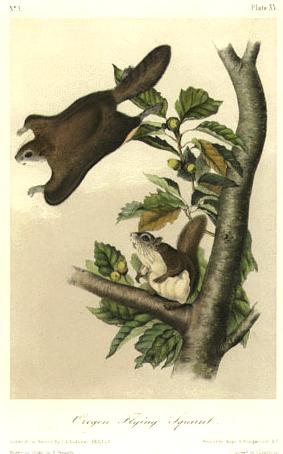

15 Oregon Flying Squirrel
PTEROMYS OREGONENSIS.--Bachman.
[Glaucomys sabrinus]
OREGON FLYING SQUIRREL.
[Northern Flying Squirrel]
PLATE XV.--MALE AND FEMALE.
P. magnitudine inter P. volucellam et P. sabrinum medius, supra fuscus,
subtus luteo-albus; auribus P. sabrini auriculis longioribus; vellere densiore,
membrana volatica largiore, pedibus grandioribus.
CHARACTERS.
Intermediate in size between P. volucella, and the Northern species, P.
sabrinus; ears, longer than in the latter, and far more compact; lobe of the
flying membrane joining the fore-feet, much longer in proportion, making that
membrane broader. Foot larger; general colour above, brown; beneath,
yellowish-white.
SYNONYME.
PTEROMYS OREGONENSIS; Oregon Flying Squirrel, Bach., Jour. Acad. of Nat.
Sciences, Phil., vol. viii., pt. i., p. 101.
DESCRIPTION.
This species differs from P. sabrinus, in several very striking
particulars; the arm which supports the flying membrane is 11 1/2 lines in
length, whilst that of the latter is only 9. Thus the smaller of the two has
the largest flying membrane.
The fur of P. sabrinus is much the longest, and is white, whilst that of P.
Oregonensis has a yellowish tinge. The hairs on the tail of the former are only
slightly tinged with lead-colour at the roots, whilst in the latter that colour
extends outwardly, (towards the tips,) for half their length. The different
shape of the ear, it being longer and narrower in our present species than in P.
sabrinus, is a sufficient distinctive character. P. Oregonensis differs from
the common flying squirrel (P. volucella) so entirely, that it is hardly
necessary to give a particular comparison. Besides being much larger than the
latter, and not possessing the beautiful downy-white on the belly, it, may be
distinguished from P. volucella by the hairs on that species being white to the
roots, which is not the case with the Oregonensis. Whiskers, numerous, and very
long.
COLOUR.
Fur, deep gray at the base, on the back tipped with yellowish-brown; tail,
pale-brown above, dusky toward the extremity; beneath, brownish-white; whiskers,
chiefly black, grayish at the tips. Hairs covering the flying membrane, mostly
black, slightly tipped with pale-brown; feet, dusky; around the eyes, brackish;
ears, with minute adpressed brown hairs externally, and brownish-white
internally.
DIMENSIONS.
Inches. Lines.
Length from point of nose to root of tail . . . . 6 8
Tail, to point of fur . . . . . . . . . . . 6 0
Height of ear posteriorly. . . . . . . . . . 0 7
Breadth between the outer edges of the
flying membrane . . . . . . . . . . . . 8 0
Longest hind-toe, including nail . . . . . . . 0 5 1/4
Longest fore-toe, including nail . . . . . . . 0 5 1/2
From heel to point of nail . . . . . . . . . 1 6 1/2
From nose to ear. . . . . . . . . . . . . 1 6
HABITS.
The habits of this handsome Flying Squirrel, we regret to say, are almost
unknown to us; but from its general appearance, it is undoubtedly as active and
volatile as our common little species; and much do we regret that we have never
seen it launch itself into the air, and sail from the highest branch of one of
the enormous pines of the valley of the Columbia river, to some other tall and
magnificent tree. Indeed, much should we like to know the many works of the
Creator that yet remain to be discovered, examined, figured, and described, in
the vast mountain-valleys and forests beyond the highest peaks of the great
Rocky Chain.
We hope, however, to obtain a good deal of information through various
sources ere the conclusion of this work, from the remote portions of our
Continent that have not yet been well explored by naturalists, and we shall then
perhaps be able to say something more in regard to the subject of this article,
of which we can now only add, that Mr. TOWNSEND remarks, that it inhabits the
pine woods of the Columbia, near the sea, and has the habits of P. volucella.
GEOGRAPHICAL DISTRIBUTION.
Dr. RICHARDSON (Fauna Boreali Americana, p. 195) speaks of a Flying
Squirrel which was "discovered by Mr. DRUMMOND on the Rocky mountains, living in
dense pine-forests, and seldom venturing from its retreats except in the night."
This animal he considers a variety of P. sabrinus, (var. B. Alpinus.) The
locality in which it was found, and parts of his description, however, on the
whole incline us to suppose that the specimen procured by Mr. DRUMMOND was one
of our present species, although of a very large size. Dr. RICHARDSON says, "I
have received specimens of it from the head of Elk river, and also from the
south branch of the Mackenzie." So that if this supposition be correct, we may
conclude that it inhabits a very extensive tract of country, and is, perhaps,
most common on, and to the west, of the Rocky Mountains; in which last locality
Mr. TOWNSEND met with it in the woods on the shores of the Columbia river.
GENERAL REMARKS.
There are no accounts of this species of Flying Squirrel, or of the larger
one, P. sabrinus, in LEWIS and CLARKE'S Journal. Those travellers not having,
as we suppose, heard of either, although they traversed a considerable portion
of the country in which both species have since been found.
We hope, when presenting an account of the habits of P. sabrinus, to be
able to identity the variety above-mentioned, (P. sabrinus, var. B. Alpinus of
RICHARDSON,) and if necessary, correct any error in our account of the
geographical distribution of the present species (P. Oregonensis.)
|